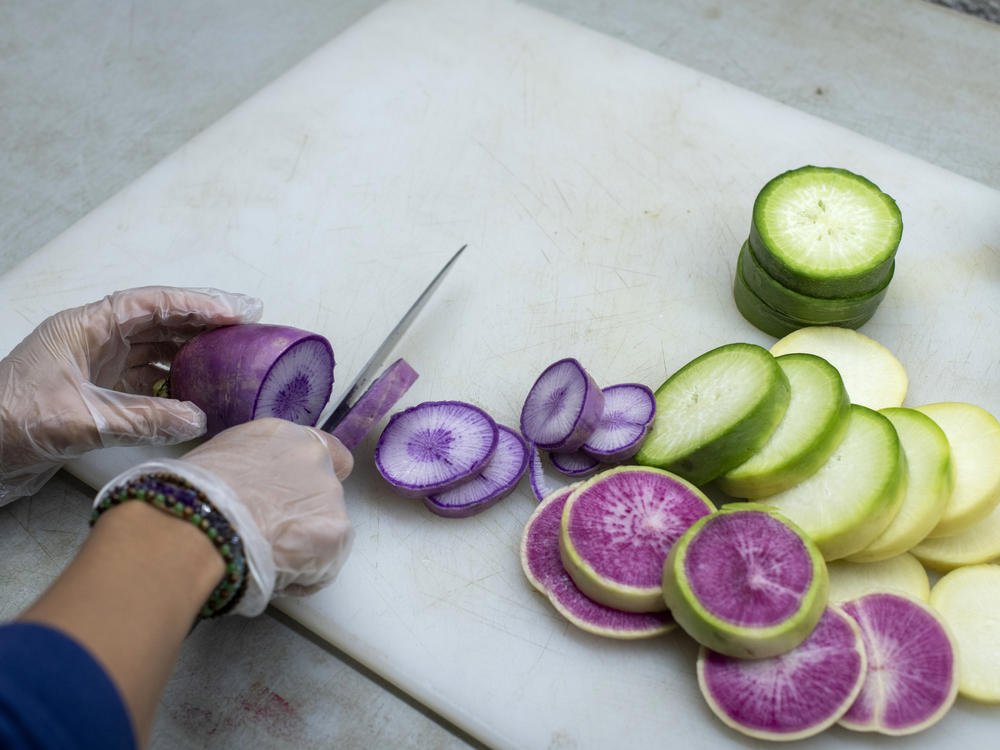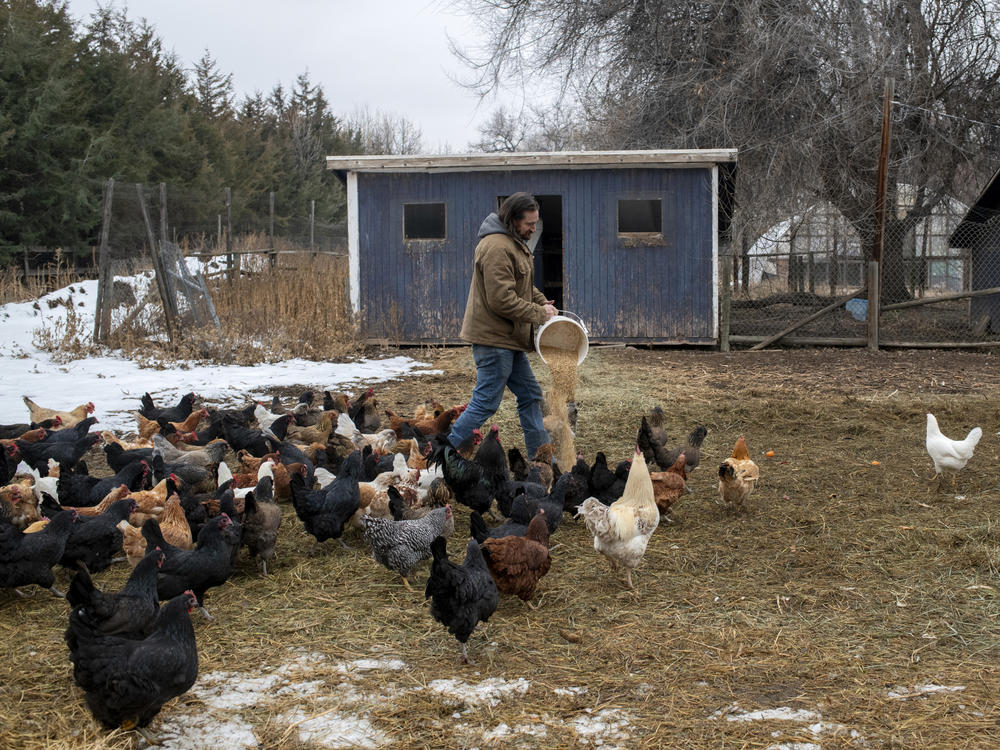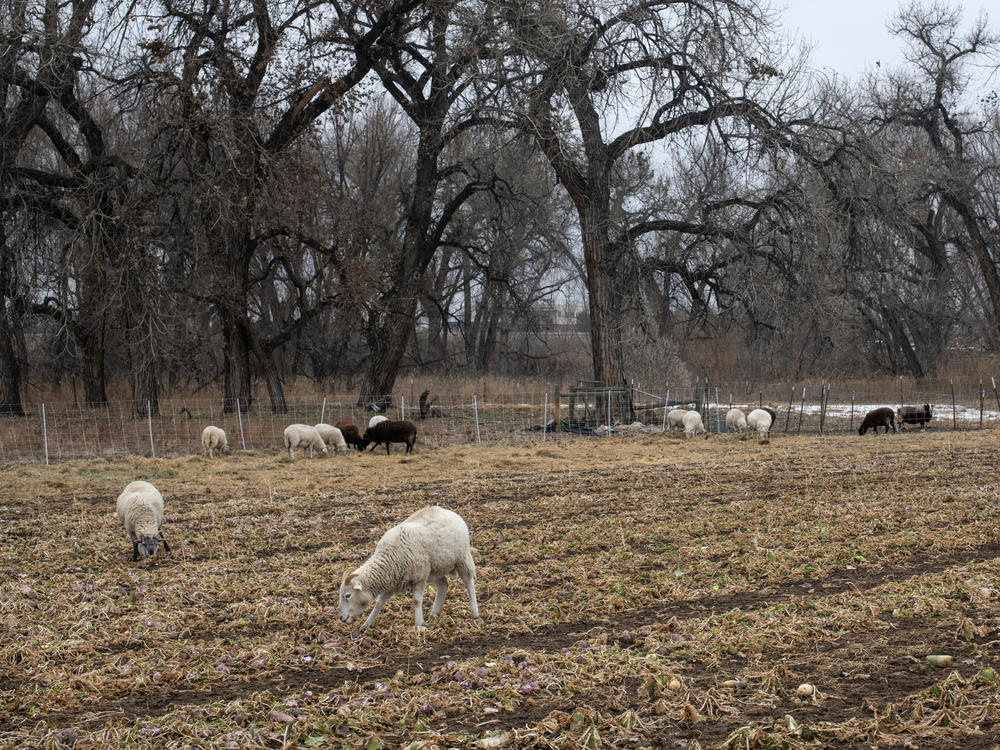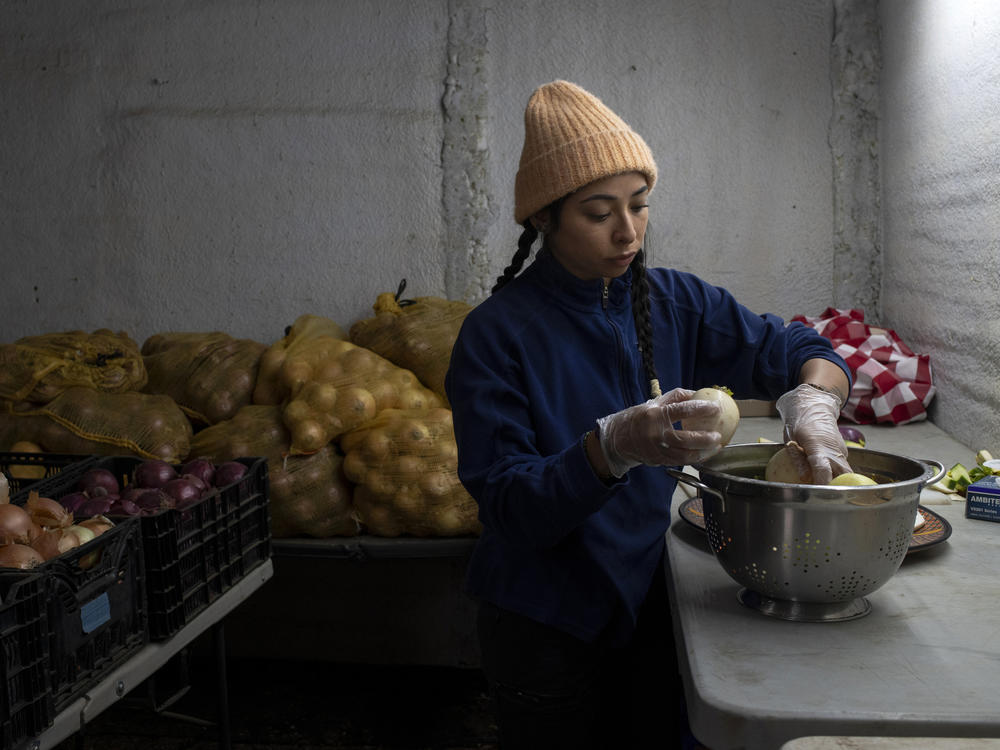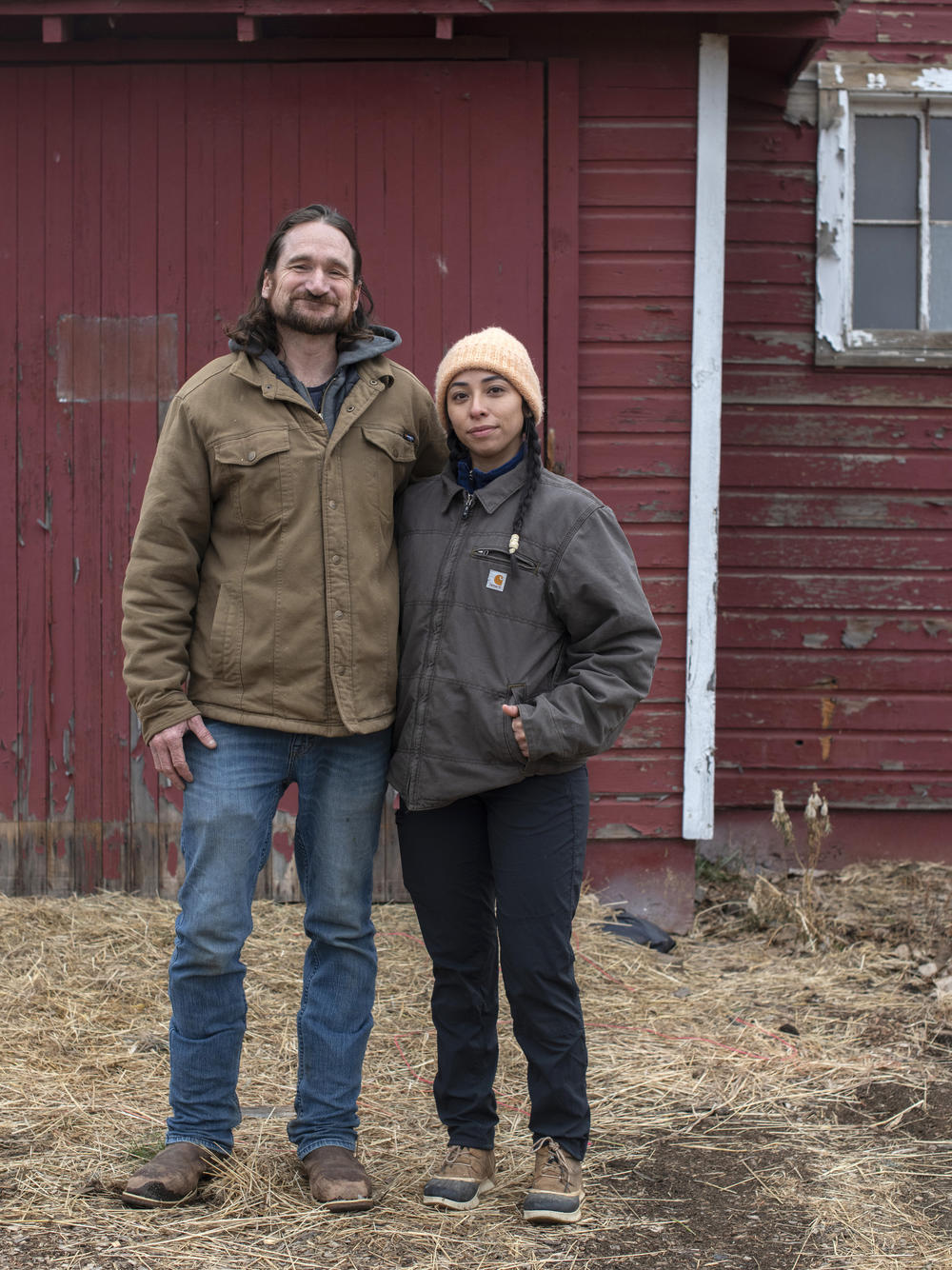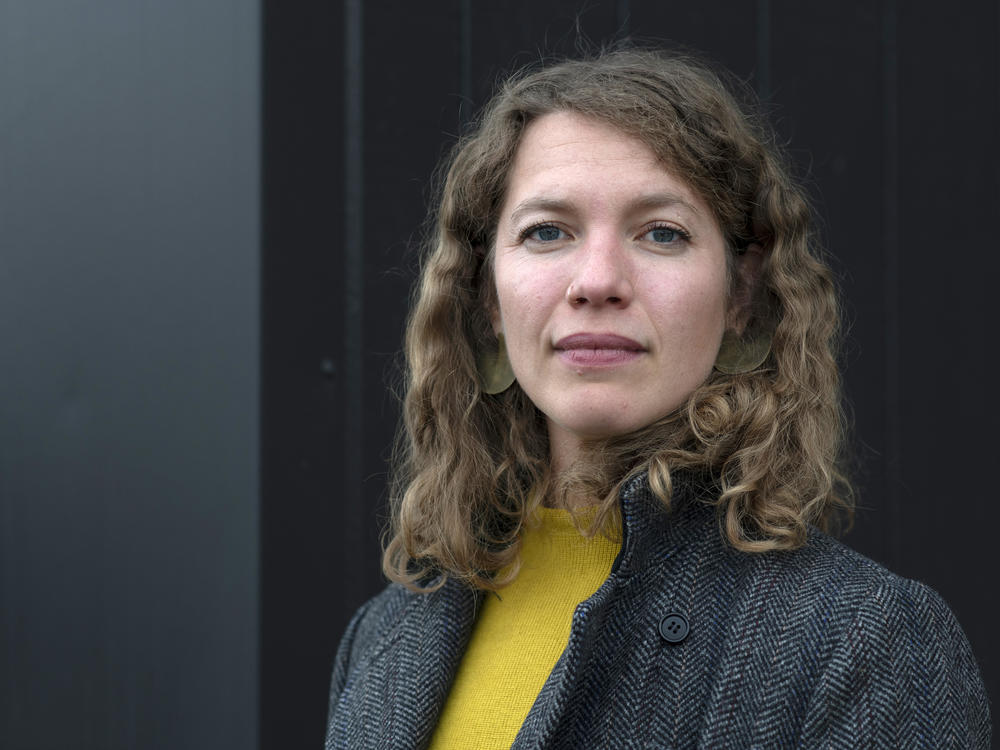Section Branding
Header Content
A big idea for small farms: How to link agriculture, nutrition and public health
Primary Content
In a chilly storeroom piled high with fall produce, Jimena Cordero is chopping up vegetables and fanning them out onto trays.
Cordero is the farm manager at Ollin Farms, not far from Boulder, Colo. — she's put together bright pink and purple radishes, apple, fresh turnips.
"This is a green luobo," she explains, as she expertly cuts the oblong radish into rounds.
These locally grown vegetables aren't just pretty. They're being prepared to make a case to state lawmakers at a meeting later that afternoon.
"You can have a super colorful veggie tray for a meeting, and everybody can get on the same vibration, eating the same good, healthy food," says Cordero's dad, Mark Guttridge, who started this farm with his wife, Kena, 17 years ago.
That vibration and the good, healthy food are part of the case Guttridge wants to make that farmers can play an important role in public health nutrition programs. At the meeting with about a dozen local farmers, two state representatives, and the Colorado commissioner of agriculture, Guttridge will explain how Boulder county has made creative investments in his farm that could be scaled up to the state or even national level.
Healthy soil to healthy population
Before the meeting, Guttridge shows me one of those investments. A dozen sheep mill about in a field bordered by a simple white fence. The animals, which Guttridge raises for wool, munch on radishes that have been leftover for them. And as they eat, they poop.
"So these guys are out fertilizing the radish field," Guttridge laughs. "They'll be out here a couple more weeks, and then it'll sit for about four or five months. And then we'll just till that in and get our next summer veggies planted right there."
Around the field is a special moveable type of fencing that Ollin Farms bought using grants from the Boulder County Sustainability Office. It allows them to move the sheep from one field to another, fertilizing as they go. He's also used grants for a farm compost system to fertilize the fields that the sheep don't graze on.
The goal of these investments is "really building up our soil health," he explains. "That relates directly to the nutrient quality and nutrient density of the food — healthy soil grows healthy food."
The county also makes an effort to get that healthy food out to different communities to be able to boost public health.
That's where the Boulder County Public Health department comes in. It created a coupon program that low-income families — many of mixed immigration status — can use to get free fruits and vegetables from Ollin Farms' farm stand.
"It's great because it brought a little more diversity to our farm stand – new people, new families," Guttridge says. "We're trying to make it more of a place where people come and get their food, but they also hang out and learn." He is hoping the new customers will learn about the values of sustainable farming – and how tasty its produce can be.
Win, win, win
Nutrition incentive programs, like those public health fruit and vegetable coupons, are spreading all over the country, and most are funded through the federal farm bill.
Amy Lazarus Yaroch, executive director at the Gretchen Swanson Center for Nutrition, says these programs generally have broad bipartisan support. "It's a triple win," she explains. "It's basically good for the consumer who lives in that particular community because they're getting the healthy food, it's good for the farmer, and then it's good for the economy," she explains.
Then again, these programs only help local farmers if people use their incentives on food that's grown locally. Guttridge says that it's a challenge to compete with cheaper food and produce at the big grocery stores in town, where a lot of people in Boulder and neighboring Longmont go to redeem their fruit and veg coupons.
He argues that processed food is already subsidized, so it's not a fair fight. Jim Krieger, executive director of a nonprofit called Healthy Food America, says Guttridge is right.
"There's lots of subsidies for soy and corn – they're key ingredients for ultra-processed foods, which makes their price artificially low relative to fresh fruits and vegetables," Krieger says.
Governments can use regulations to block people from using their nutrition incentives at big box grocery stores so they're forced to use them in the local food system, but Boulder county isn't taking that approach.
Instead of sticks, they're using carrots – trying to make locally farmed produce easier to access and better than the flown-in competition.
A force for good
Not far from Ollin Farms in Longmont, Colo., Boulder County Farmer's Market uses a big warehouse as a food hub, bringing together produce from lots of different local farms for distribution and delivery.
Mackenzie Sehlke, the organization's executive director, pulls open the door of a walk-in refrigerator. "A lot of storage crops in here right now," she says.
Sehlke argues that one big advantage of buying from local farmers is that they can be responsive to the community. "We have a large Nepalese community here," she says. "So we're starting to hear more about staple goods from the Nepalese cuisine and thinking about – will someone grow a specific green or a specific tuber for that population?"
Having people from different backgrounds become part of the local food scene pushes farmers to think about what else they can grow, she says. "I talked to someone who just had gotten a request for Crowder Peas, which are very common in African diaspora cuisine and would grow really beautifully here," she says.
Yes, she acknowledges, there are plenty of big structural problems with America's food system, but she's proud of what Boulder county has been able to do with local tax revenue to make local produce affordable to more people.
"I think that that local dynamism and that local innovation is pretty cool," she says. "And I've also seen it push the state and other municipalities to think differently."
Policy can be a force for good, she says, to forge connections between farmer, market and hungry resident — so it's easier and more affordable to eat locally grown food.
Copyright 2024 NPR. To see more, visit https://www.npr.org.
